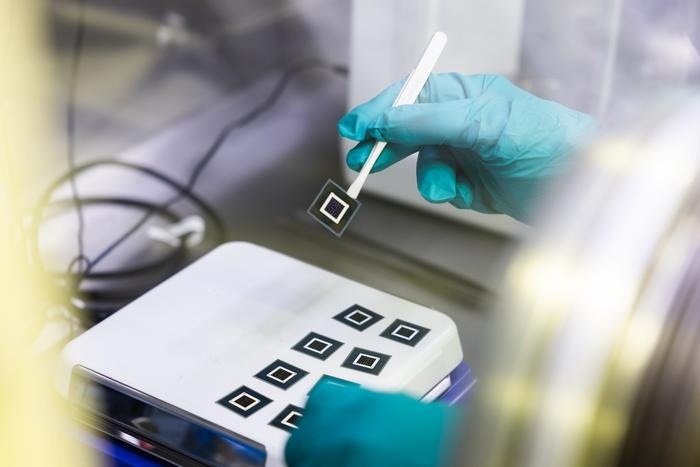An international team of photovoltaics scientists have achieved a critical breakthrough in solar tech by successfully passivating perovskite layers on textured silicon. This could enable mass-producible, ultra-efficient tandem solar cells.

An image of a perovskite silicon tandem solar cell made by the researchers. Image Credit: KAUST
The work, carried out by an international team from KAUST, the University of Freiburg, and the Fraunhofer ISE, could accelerate the transition from lab-scale prototypes to industrial-scale production of perovskite panels.
Tandem solar cells, which stack a perovskite layer atop a silicon one, are widely seen as the future of photovoltaic energy. Silicon cells have pushed their efficiency close to the theoretical limit of 29.4 %, but tandems are already pushing far beyond that benchmark in lab conditions. However, preparing these cells for mass manufacturing is a hard feat.
The biggest road block is that silicon cells in the solar industry mostly have textured surfaces covered in tiny pyramid-like structures which are designed to trap more light and boost performance. This design makes it difficult to deposit high-quality perovskite layers on top, especially with the kind of surface passivation needed for stability and efficiency.
In the latest study, published in Science, researchers have shown that it's possible. By applying a compound called 1,3-diaminopropane dihydroiodide, they have managed to passivate perovskites on top of the solar cells despite the textured surface.
Their study resulted in a power conversion efficiency of up to 33.1 % and an open-circuit voltage of 2.01 volts, benchmarks for the technology.
So far, effective passivation has not been fully harnessed on textured perovskite silicon tandem solar cells, with prior success largely confined to flat-front architectures. But we have now managed excellent passivation by depositing 1,3-diaminopropane dihydroiodide on the uneven perovskite surface.
Dr. Oussama Er-Raji, Study Lead Author, and Scientist, Fraunhofer ISE
The breakthrough also uncovered some unexpected results. In silicon cells, surface passivation mainly affects the top few layers. But here, it appeared to improve the performance of the entire perovskite absorber, something the team attributes to the "deep field effect". This phenomenon boosts conductivity and fill factor across the full thickness of the perovskite layer.
This realization provides a solid foundation for all future research in this area. It enhances our understanding of the processes occurring in the top cell while converting light into electricity, enabling scientists to leverage this knowledge to develop better tandem solar cells.
Stefaan De Wolf, Professor, Materials Science and Engineering and Applied Physics, KAUST
This kind of surface passivation isn't just about squeezing out extra performance, it's vital for long term stability.
For today’s silicon solar cells, surface passivation was the key for high efficiencies in industrial production, and it is encouraging that the photovoltaic industry will benefit from these positive effects for perovskite silicon tandem solar cells as well
Stefan Glunz, Professor, Photovoltaic Energy Conversion, University of Freiburg
The researchers' findings build on previous work from the Fraunhofer lighthouse project MaNiTU, as well as the PrEsto and Perle projects, which were both funded by the Federal Ministry for Economic Affairs and Energy.
Journal Reference:
Messmar, C., et al. (2025) Electron accumulation across the perovskite layer enhances tandem solar cells with textured silicon. Science. doi.org/10.1126/science.adx1745